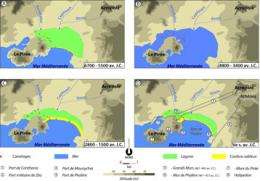The Port of Athens was once an island

Piraeus, the main port of Athens, was an island from 4 800 – 3 400 BC, in other words 4 500 years before the Parthenon was built on the Acropolis. This discovery was made by a French-Greek team led by Jean-Philippe Goiran, a CNRS researcher, who studied and dated sediments collected in the Piraeus area. The research was carried out in collaboration with colleagues from the Universities of Athens, Paris 1 and Paris Ouest, and is published in the June 2011 issue of the journal Geology.
Looking at Piraeus today, it is hard to believe that this urban area was once an island separated from the mainland by a stretch of water. And yet, in the first century AD, the Greek geographer Strabo hypothesized that Piraeus had once been an island. Located approximately seven kilometers southwest of Athens, this vast rocky hill was home to the three ancient ports of the Greek capital, Zea, Mounichia and Cantharos. During the fifth century BC, this strategic place was connected to Athens by a road protected by high walls, known as the 'Long Walls', that guaranteed safe travel.
Until recently, no archeological research had ever been carried out to verify Strabo's hypothesis. To put his intuition to the test, researchers from France and Greece took around ten geological core samples from boreholes over 20 meters deep in what is today the Cephissus (Kifisos) plain located between Piraeus and Athens. They compared the sedimentary records contained in the core samples with written records. Each sedimentary bed was dated using the carbon-14 method. This stratigraphic study enabled the researchers to discover four main stages in the evolution of coastal landscapes in the Piraeus region.
During the first stage, 6 700 – 5 500 BC, sea levels in the Mediterranean were considerably lower than today. The hill of Piraeus was not an island and was geographically connected to the mainland. Then from 4 800 – 3 400 BC, sea levels rose, and Piraeus became an island. During the third stage, from 2 800 BC on, sea levels started to rise more slowly, while at the same time massive amounts of sediment were carried down by rivers in the region. This dual phenomenon caused sediments to build up on the Cephissus plain, which led to the establishment of a lagoon environment. Finally, in the fifth century BC, at the time the Parthenon was being built on the Acropolis, the lagoons were still present. To build the Long Walls, the engineers of the time were therefore forced to fill in these wetlands.
Since Strabo lived some 3 500 years after Piraeus was an island, what lies behind his intuition? One possible explanation is that he based his opinions on texts written by his predecessors. Another possibility is that he carried out an analysis of the coastal landscape when he travelled to Athens in the first century AD: at the time, the rocky hill of Piraeus stood above a still marshy coastal plain. And finally, Strabo may have used both these sources to work out that the sea must have been present between Athens and Piraeus at an earlier period.
More information: Piraeus, the ancient island of Athens : Evidence from Holocene sediments and historical archives. Jean-Philippe Goiran, et al. Geology, June 2011
Provided by CNRS



















